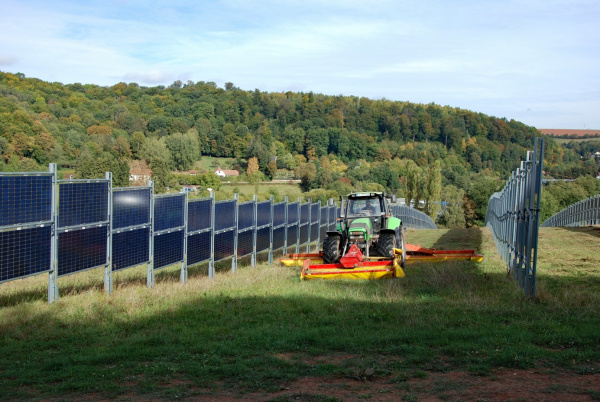Photovoltaik auf Agrarflaechen/en: Unterschied zwischen den Versionen
Tschug (Diskussion | Beiträge) |
Tschug (Diskussion | Beiträge) |
||
| Zeile 15: | Zeile 15: | ||
The decision-making process was complemented by a consultation involving public-sector agencies, some of whose requests for changes were taken into account when designating suitable areas or were referred for a final decision to local government authorities.</p> |
The decision-making process was complemented by a consultation involving public-sector agencies, some of whose requests for changes were taken into account when designating suitable areas or were referred for a final decision to local government authorities.</p> |
||
| + | <p>Saarland’s state government adopted this ordinance on 27 November 2018.</p> |
||
| − | <p>Das saarländische Kabinett hatte diese Verordnung am 27.11.2018 verabschiedet.</p> |
||
<p>Mittlerweile sind die in der Verordnung benannten 100 MW peak an Leistung in den Ausschreibungen der Bundesnetzagentur vergeben worden. Daher wurde eine Änderungsverordnung notwendig, diese umfasst weitere 250 MW peak und gilt bis zum 31.12.2025. Verändert hat sich auch die Flächenkulisse. Durch Herausnahme weiterer Vorranggebiete verringert sie sich von 8.300 ha auf 7.470 ha.<br /> |
<p>Mittlerweile sind die in der Verordnung benannten 100 MW peak an Leistung in den Ausschreibungen der Bundesnetzagentur vergeben worden. Daher wurde eine Änderungsverordnung notwendig, diese umfasst weitere 250 MW peak und gilt bis zum 31.12.2025. Verändert hat sich auch die Flächenkulisse. Durch Herausnahme weiterer Vorranggebiete verringert sie sich von 8.300 ha auf 7.470 ha.<br /> |
||
Version vom 24. März 2022, 13:20 Uhr
Photovoltaics on agrarian land
Viewer
Go to application ‘Photovoltaics on agrarian land’
Description
The state government has set itself the target of further expanding the percentage of green electricity consumed in Saarland beyond the 20 percent mark already achieved in 2020.
To address the issue of a lack of space for installing photovoltaic plants, the Ministry for the Economy, Labour, Energy and Transport convened a roundtable for photovoltaic systems on agrarian land. Headed by Dept. F/1 (Fundamental Issues in Energy Policy) within the Ministry for the Economy, Labour, Energy and Transport, other members of this roundtable included the Farmers Association, the Chamber of Agriculture, project planners from the photovoltaic industry, citizen energy cooperatives, state planning (Ministry for the Interior, Building and Sport) and experts working in conservation and agriculture (Ministry for the Environment and Consumer Protection). Dept. F/1 (State Monuments Office) from the Ministry for Education and Culture also attended sessions in an advisory role
A basic agreement was achieved by roundtable members, whereby an ordinance as recommended by the Saarland Energy Council was to be created at state level corresponding to the option set out in the German Renewable Energy Sources Act for utilising agrarian land in disadvantaged areas for ground-mounted photovoltaic arrays. In accordance with the terminology used in section 3(7) of the Renewable Energy Sources Act, ‘disadvantaged areas’ are understood to mean areas as defined by Council Directive 86/465/EEC of 14 July 1986 concerning the Community list of less-favoured farming areas within the meaning of Directive 75/268/EEC (OJ L 273 of 24/09/1986, p. 1), as amended by Commission Decision 97/172/EC (OJ L 72 of 13/03/1997, p. 1). The decision-making process was complemented by a consultation involving public-sector agencies, some of whose requests for changes were taken into account when designating suitable areas or were referred for a final decision to local government authorities.
Saarland’s state government adopted this ordinance on 27 November 2018.
Mittlerweile sind die in der Verordnung benannten 100 MW peak an Leistung in den Ausschreibungen der Bundesnetzagentur vergeben worden. Daher wurde eine Änderungsverordnung notwendig, diese umfasst weitere 250 MW peak und gilt bis zum 31.12.2025. Verändert hat sich auch die Flächenkulisse. Durch Herausnahme weiterer Vorranggebiete verringert sie sich von 8.300 ha auf 7.470 ha.
Die Änderungsverordnung wurde am 02.03.2021 vom saarländischen Kabinett verabschiedet.
Downloads
- Text der Verordnung (Amtsblatt des Saarlandes)
- Text der Änderungsverordnung (Amtsblatt des Saarlandes)
Ansprechpartner
Ministerium für Wirtschaft, Arbeit, Energie und Verkehr
Referat F/7 "Grundsatzfragen der Energiepolitik"
Henrike Jacob
E-Mail-Kontakt
Telefon: +49 681 501-3246
